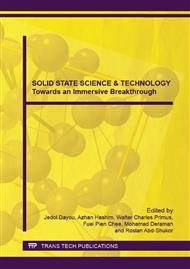p.347
p.353
p.359
p.365
p.371
p.377
p.383
p.391
p.397
Effect of Strontium on the Catalytic Activity and Physicochemical Properties of Ru/Mn Catalysts for CO2 Methanation Reaction
Abstract:
The recycling technology by the catalytic conversion offers a very promising technique for reducing greenhouse CO2 gas from flue gases of coal burning power plant by converting the carbon dioxide gas to methane. The methane produced from the reaction can be used as other fuel to run turbine for electricity generation. Therefore, the strontia based catalysts was prepared by impregnated with RuMn/Al2O3 catalyst and then calcined at 1000°C for 5 hour. Strontia catalyst is an effective material because of its highly basic properties which could enhance carbon dioxide adsorption and chemisorption on the catalyst surface but not been widely explored. The result obtained revealed that the addition of Sr to RuMn/Al2O3 as based catalyst had increased the catalytic activity and found to be more active for promoting the CO2 methanation reaction. Under reducing pretreatment at 300°C, the activity of CO2 conversion increased about 30.98% which is from 50.45% over RuMn-65/Al2O3 catalyst to 73.10% over RuMnSr-65/Al2O3 catalyst with 40% of methane yielded at reaction temperature of 210°C. The Sr addition did not modify the crystalline structure of the catalyst but gave higher surface area, smaller particle size and high metal dispersion as well as increased the degree of reduction and CO chemisorption.
Info:
Periodical:
Pages:
371-376
Citation:
Online since:
June 2015
Authors:
Keywords:
Price:
Сopyright:
© 2015 Trans Tech Publications Ltd. All Rights Reserved
Share:
Citation:


